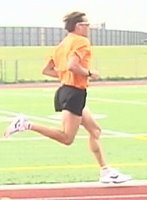More on Footstrike in Running
Research typically finds that how long your foot is in contact with the ground is closely related to how quickly you run [1,2]. This makes sense since a foot on the ground is essentially an anchor. You aren't going any place until it comes off the ground. The longer it stays fixed to terra firma the slower you will run. A recent Japanese study provides a lesson in this and reveals how to go about running faster without elevating VO2max or lactate threshold simply by shortening ground-contact time [3].
The Japanese researchers videotaped and later studied the footstrikes of 415 runners including elite international and Olympian runners at the 15-km point in a half marathon. Of these runners 74.9% were found to be rearfoort strikers (RFS), 23.7% were midfoot strikers (MFS), and 1.4% were forefoot strikers (FFS). The percentage of MFS was highest in the fastest runners. Time in contact with the ground was, on average, 9% longer in the RFS (200 +/-23.3 milliseconds) compared with the MFS and RFS (183 +/-16msec). The RFS runners had the slowest race times and MFS the fastest.
The Base period is the time to improve your running technique and for most runners the quickest way to become a faster runner before next season is to become more economical by learning to run with a midfoot strike rather than a heel strike. If you want to see what this looks like go to www.trainingbible.com and click on FREE RESOURCES to find a video of a runner who uses the MFS technique. Be aware that forcing a dramatic change in footstrike in a short period of time can result in foot and leg injuries. Allow several weeks for the change by gradually increasing how much time you run with the new technique.
References
1. Paavolainen L, et al. 1999. Explosive strength training improves 5-km running time by improving running economy and muscle power. Journal of Applied Physiology 86(5):1527-1533.
2. Paavolainen L, et al. 1999. Neuromuscular characteristics and fatigue during 10-km running. International Journal of Sports Medicine 20(8):516-521.
3. Hasegawa H, et al. 2007. Footstrike patterns of runners at the 15-km point during an elite-level half marathon. Journal of Strength and Conditioning Research (21(3):888-893.
Labels: footstrike, running


